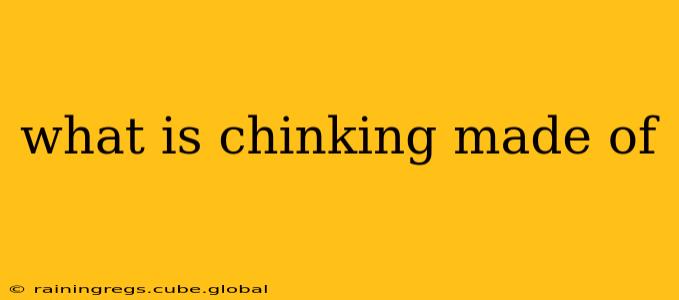Chinking is the crucial material used to seal the gaps between logs in a log cabin or similar structure. It’s more than just a cosmetic finish; it’s essential for weatherproofing, insulation, and the overall longevity of the building. But what exactly is chinking made of? The answer isn't as simple as a single ingredient. The composition of chinking varies depending on factors like desired performance, budget, and the aesthetic preferences of the builder.
What are the Main Components of Chinking?
Generally, chinking mixes combine several key ingredients:
-
Binder: This is the glue that holds everything together. Common binders include Portland cement, lime, and acrylic polymers. Cement-based chinks are durable and long-lasting but can be less flexible. Lime-based chinks offer greater flexibility and breathability, while acrylics provide a fast-drying, paintable finish.
-
Aggregate: This provides bulk and texture. Common aggregates include sand, finely ground limestone, and even perlite or vermiculite for improved insulation properties. The size and type of aggregate will influence the final texture and workability of the chinking.
-
Pigments: These are added to achieve the desired color. Natural earth pigments or commercial colorants can be used to match the log color or create a contrasting look.
-
Water (or other liquids): Water is usually the mixing liquid, but some chinking mixes may utilize other liquids depending on the binder used and desired properties.
What are Different Types of Chinking?
Several types of chinking exist, each with its own composition and properties:
1. Cement-Based Chinking
Cement-based chinking is known for its exceptional durability and resistance to the elements. It's a popular choice for its longevity but can be less flexible and more prone to cracking if the log structure settles significantly. It usually requires a more experienced hand to apply correctly.
2. Lime-Based Chinking
Lime-based chinking is prized for its breathability. This means it allows moisture to escape, preventing the build-up of condensation and rot within the log walls. It’s often considered more environmentally friendly and can provide a more natural aesthetic. It tends to be less durable than cement-based chinking, requiring more frequent maintenance.
3. Acrylic Chinking
Acrylic chinking is a fast-drying, paintable option offering good flexibility and water resistance. It's relatively easy to apply, making it a popular choice for DIY projects. However, it might not be as durable in the long run as cement-based options and might not have the breathability of a lime-based chink.
What are the Alternatives to Traditional Chinking?
While traditional chinking mixes are prevalent, there are alternatives worth considering:
-
Caulk: Traditional caulks, like silicone or polyurethane, can be used to seal smaller gaps, but they generally aren't suitable for large gaps or extensive chinking needs.
-
Foam Sealants: Spray foam sealants can effectively fill large gaps but might not offer the aesthetic appeal of traditional chinking and may require additional finishing.
How Do I Choose the Right Chinking?
The best chinking for your log cabin depends on several factors:
-
Climate: In harsher climates, a durable cement-based chinking might be preferable. In milder climates, a lime-based or acrylic option could suffice.
-
Budget: Cement-based chinking is often the least expensive, while acrylic chinking may fall in the middle, and lime-based can be more expensive depending on the specific product.
-
Aesthetic Preference: Consider the desired color, texture, and overall look of the finished chinking.
-
DIY or Professional Installation: Acrylic chinking is generally easier for DIY projects, while cement-based chinking often requires more expertise.
This information should provide a thorough understanding of chinking composition and the various options available. Remember to consult with a professional if you're unsure which type of chinking is best suited for your project. Choosing the right chinking material is key to the long-term health and beauty of your log cabin.
